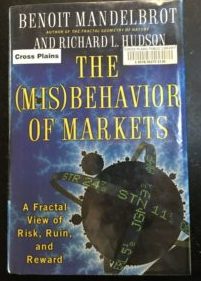The (Mis)behavior of Markets by Benoit Mandelbrot and Richard L. Hudson
Benoit Mandelbrot was the famous mathematician who developed fractal geometry (he passed away in 2010). This book was published in 2004 and is the culmination of his work in applying fractals to economics and market behavior.
The primary message of the book is that the foundation of modern financial theory is based on assumptions that are just not correct. Here is what he calls the Ten Heresies of Finance, things that he argues are true but conflict with the assumptions economists make in their financial models:
- Markets are turbulent.
- Markets are very, very risky – more risky than standard theories imagine.
- Market “timing“ matters greatly. Big gains and losses concentrate into small packages of time.
- Prices often leap, not glide. That adds to risk.
- In markets, time is flexible. When things are happening they happen very quickly and over short time frames.
- Markets in all places and ages work alike.
- Markets are inherently uncertain, and bubbles are inevitable.
- Markets are deceptive.
- Forecasting prices may be perilous, but you can estimate the odds of future volatility.
- In financial markets, the idea of “value“ has limited value.
He applies his knowledge of mathematics to demonstrate why these things are true, but he does it mainly through diagrams and graphs rather than equations. This is an excellent way to simplify a very complex subject.
The end result of all of this is that the financial models (that remain in wide use today) grossly underestimate financial risk and the probability of the type of market disruption seen in 2008.
My favorite quote from the book: “Compared with other disciplines, economics tends to let its theory gallup well ahead of its evidence.”
